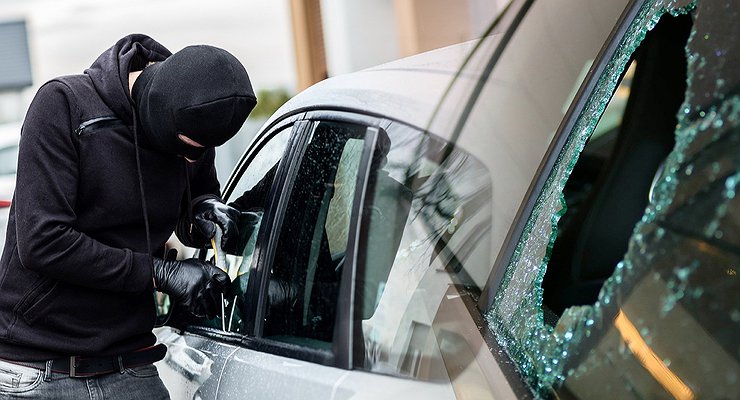With car prices skyrocketing due to an acute shortage and car thieves becoming more active (the growth of truck cranes has increased by 25% in the past three months), many drivers are thinking about how to strengthen the protection of their “swallows”. Some consider installing additional alarms, others consider installing the so-called anti-theft markings. What is this procedure, what are its advantages and disadvantages, and most importantly, how effective it is, the AvtoVzglyad portal found out.
For those who did not know, and even forgot, we remember that the anti-theft marking of car parts is not an innovation, it was invented at the end of the last century. In the 2000s, the popularity of the procedure waned somewhat, but now that the issue of preserving valuables has become particularly acute, demand for the service has started to grow again.
Unlike anti-theft systems that block the engine, gearbox, steering or braking systems, marking is of course no obstacle to scammers. It works differently: it just scares them off. Wise thieves don’t mess with “marked” cars because they cause unnecessary trouble – such cars (or their parts) are extremely difficult to resell and the risk of ending up behind bars is high.
Sounds promising in theory. But is anti-theft marking really that effective in practice?
To begin with, let’s talk briefly about what this procedure actually is. Anti-theft marking is the application of a unique combination of letters and numbers (VIN number or part thereof) to car parts by chemical or mechanical means. More specifically, at the request of the car owner, you can mark all windows, mirrors, optics, doors, trunk lid, interior elements, any units and components.
In order to deter car thieves, conspicuous, easily legible markings are usually applied to the external elements – especially on the side windows. And if this does not help, and the car leaves the parking lot in an unknown direction, information about the procedure performed is transferred to law enforcement officers. That is, any traffic cop who has access to databases can quickly check who is in front of him: an “authorized” person or a kidnapper.
“And is it really impossible to get rid of the mark?” – you may be wondering. It will not work to remove the engraving so that no trace is left behind. The only way to “anonymize” a car is to replace the marked parts. But this is not economically feasible, and what to do with the removed elements? You cannot sell them on the “black” market – whoever needs engraved parts, this is a “criminal”. In general, for tagged car thieves – not a “snack”, but a complete headache.
Among other advantages of anti-theft marking, it can be noted that it does not harm glass, mirror and other elements; it has no “expiry date” – it does not need to be maintained or periodically updated in any way; the process itself takes relatively little time (about 15 minutes per part) and, oddly enough, doesn’t ruin it. For example, in Moscow, the price for marking one part starts from 500 rubles.
Of course, counting “on a circle” can add up to a decent amount, and even for some – unbearable. On the other hand, reliable anti-theft systems are much more expensive, and thieves have already learned how to work with many of them. The main thing here is to find a competent executor – a reliable service that will do everything necessary (including sending data to law enforcement), and at the same time won’t mess up.
As for the minuses, judging by the forums, only one can be noted – bright spots slightly spoil the appearance of the car. Especially when it comes to a tuned car, luxury or some rarity. However, the owners of unique cars, as a rule, protect them very carefully: they do not skimp on anti-theft systems and guarded parking lots. Although even in such cases marking will not be superfluous …
SUBSCRIBE TO EXCLUSIVE PORTAL MATERIALS
“AUTOVIEW” IN TELEGRAMS
For those who did not know, and even forgot, we remember that the anti-theft marking of car parts is not an innovation, it was invented at the end of the last century. In the 2000s, the popularity of the procedure waned somewhat, but now that the issue of preserving valuables has become particularly acute, demand for the service has started to grow again.
Unlike anti-theft systems that block the engine, gearbox, steering or braking systems, marking is of course no obstacle to scammers. It works differently: it just scares them off. Wise thieves don’t mess with “marked” cars because they cause unnecessary trouble – such cars (or their parts) are extremely difficult to resell and the risk of ending up behind bars is high.
Sounds promising in theory. But is anti-theft marking really that effective in practice?
To begin with, let’s talk briefly about what this procedure actually is. Anti-theft marking is the application of a unique combination of letters and numbers (VIN number or part thereof) to car parts by chemical or mechanical means. More specifically, at the request of the car owner, you can mark all windows, mirrors, optics, doors, trunk lid, interior elements, any units and components.
In order to deter car thieves, conspicuous, easily legible markings are usually applied to the external elements – especially on the side windows. And if this does not help, and the car leaves the parking lot in an unknown direction, information about the procedure performed is transferred to law enforcement officers. That is, any traffic cop who has access to databases can quickly check who is in front of him: an “authorized” person or a kidnapper.
“And is it really impossible to get rid of the mark?” – you may be wondering. It will not work to remove the engraving so that no trace is left behind. The only way to “anonymize” a car is to replace the marked parts. But this is not economically feasible, and what to do with the removed elements? You cannot sell them on the “black” market – whoever needs engraved parts, this is a “criminal”. In general, for tagged car thieves – not a “snack”, but a complete headache.
Among other advantages of anti-theft marking, it can be noted that it does not harm glass, mirror and other elements; it has no “expiry date” – it does not need to be maintained or periodically updated in any way; the process itself takes relatively little time (about 15 minutes per part) and, oddly enough, doesn’t ruin it. For example, in Moscow, the price for marking one part starts from 500 rubles.
Of course, counting “on a circle” can add up to a decent amount, and even for some – unbearable. On the other hand, reliable anti-theft systems are much more expensive, and thieves have already learned how to work with many of them. The main thing here is to find a competent executor – a reliable service that will do everything necessary (including sending data to law enforcement), and at the same time won’t mess up.
As for the minuses, judging by the forums, only one can be noted – bright spots slightly spoil the appearance of the car. Especially when it comes to a tuned car, luxury or some rarity. However, the owners of unique cars, as a rule, protect them very carefully: they do not skimp on anti-theft systems and guarded parking lots. Although even in such cases marking will not be superfluous …
SUBSCRIBE TO EXCLUSIVE PORTAL MATERIALS
“AUTOVIEW” IN TELEGRAMS
Source: Avto Vzglyad
I’m Sandra Torres, a passionate journalist and content creator. My specialty lies in covering the latest gadgets, trends and tech news for Div Bracket. With over 5 years of experience as a professional writer, I have built up an impressive portfolio of published works that showcase my expertise in this field.















